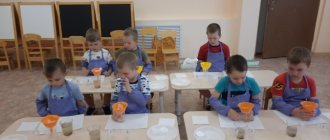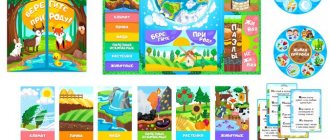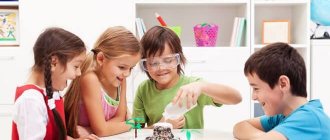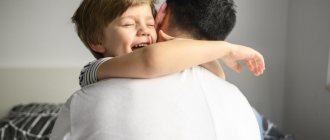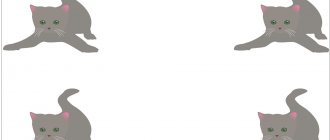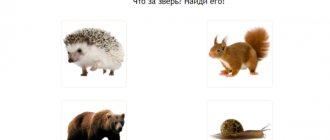All that is needed
For the experiment you will need some household chemicals and decorative elements to create an island. The volcano island can be made from natural materials or use dinosaur sensory box sets.
A model of a volcano is made from plasticine. Creating a fabulous volcanic island for the experience is the main component of it and serves to develop the child's imagination and creativity. Such activities will help instill a love for chemistry and geography. The child will develop fine motor skills of the fingers while making plasticine terrain and its inhabitants.
To make an island you need:
- cardboard;
- stapler or narrow tape;
- box with colored plasticine;
- small animal toys;
- colorful pebbles;
- a large plastic box or bowl in which the island will stand;
- glass or plastic container with a volume of 200 ml for the volcano crater.
To conduct the experiment you will need:
- soda 20 g;
- food coloring:
- vinegar 9%;
- dish detergent 25 ml;
- water 100 ml.
Usually the experiment continues until mom runs out of all the baking soda and vinegar, so be patient.
Children cannot carry out the experiment on their own without adults. If vinegar gets into a child's eyes or mouth, it can cause a burn to the mucous membranes, and if swallowed, it can cause a burn to the esophagus.
What is a volcano?
Having received the task of finding interesting information about volcanoes, a few days later we talked about the following: that a volcano is a mountain with a hole through which a fiery mixture of gases, steam and molten lava is thrown onto the surface with enormous force. The lava is so hot that there is no life left after it.
The main naughty guy, Makar Kalashnikov, told why the volcano was called a volcano? And it turned out that the word “volcano” comes from the Latin word “volcanos” - fire, flame. The ancient Romans called the God of fire and blacksmithing Vulcan. According to legend, he forged armor in his forge inside the mountain.
His forge was hot and loud. Sometimes God opened the doors to his kingdom, which caused holes to form on the surface of the earth and fire and smoke burst out from there. People said: the volcano is angry. Subsequently, all places on Earth where fire-breathing mountains were found began to be called volcanoes.
Then I (teacher L.M. Bondarenko) continue the story that Volcanoes are a formidable natural phenomenon. Volcanic eruptions threaten human life and cause damage to the entire environment, so we need to know about them as about any natural phenomenon of which we are a part.
Our country also has a range of mountains with volcanoes, we show them on the map; this is the Kamchatka Peninsula, which is washed by the seas and the Pacific Ocean.
Kamchatka is famous for its volcanoes , which sometimes sleep and sometimes wake up. Volcanic eruptions often cause earthquakes. Next, together we look at a picture diagram that helps us understand the structure of a volcano and expand our vocabulary: lava, crater, vent, eruption.
But why does a volcano still erupt? And is it only destruction that comes from a volcanic eruption?
It turned out that magma is formed in the depths of the earth's crust at very high temperatures. Under the influence of the movement of tectonic plates, magma rises to the surface of the earth and accumulates in the volcanic chamber under the volcano.
The gases that make up the magma tend to exit to the surface - to the crater, and lift the magma with them. The closer to the crater, the more gases become, the magma changes its composition and turns into lava. A volcanic eruption begins with the release of gases and volcanic ash.
Explosions can also occur, then volcanic bombs fly into the air from the vent - pieces of solidified lava, and then the molten lava flows down the slope. After a violent eruption process, the pressure decreases and the volcanic eruption stops.
Making a fairytale island
You can build an island in a large plastic container. Pour real water and line the bottom with round pebbles. Make a container for the volcano from a baby food jar or an old glass. For the mountain inside which the container will stand, you need to make a cardboard model; your child will be happy to cover it with plasticine.
The sequence of making a volcanic mountain:
- cut out a circle of the required diameter from thick cardboard;
- make a cut from the edge to the center of the circle;
- roll up a cone;
- the edges of the cone are fastened with a stapler or tape;
- cut off the upper part of the cone at a height equal to the container chosen for the volcano;
- place the container inside the cone.
I coat the top of the mountain with plasticine. To do this, roll out small brown plasticine cakes and stick them to a paper cone, completely covering the cardboard. The top of the volcano can be made of red plasticine, which will imitate hot lava.
They place a volcanic mountain on a dry island of pebbles. They are seated around small rubber animals that are among children's toys. Multi-colored amazing dinosaurs or wolves, foxes, bunnies, bears and other inhabitants of the forest and jungle. Depending on what animals were planted, vegetation for the island is selected. Large tree ferns and horsetails for dinosaurs, and ordinary fir trees and birches for bunnies and foxes.
Plastic plants are also often sold in sets for children's games. You can use a leaf of a living fern and twigs of plants if it is summer outside.
Plants can also be molded from plasticine, made from threads and beads or ordinary cardboard.
You can make small houses out of cardboard for plastic Indians and soldiers. It is better to use cardboard to make plants and houses when the island is in a container with blue-dyed sand instead of water or on a blue plasticine sea.
Experimental and creative project “Studying volcanoes” for children of senior preschool age
Belskaya Tatyana Mikhailovna
Experimental and creative project “Studying volcanoes” for children of senior preschool age
Project implementation time : 1 month
Project goal : Implementation in the educational process of cognitive and experimental activities of children of senior preschool age , through familiarization with the natural phenomenon - a volcano .
Project objectives :
1. Give an idea of volcanoes , their structure, causes of occurrence.
2. To develop the cognitive activity of children in the process of independently performing experiments according to the scheme.
3. Help students understand why volcanoes are formidable natural phenomena.
4. Develop the ability to compare, analyze, draw conclusions, and broaden the horizons of students.
5. Introduce children to “reading”
encyclopedias, getting to know new phenomena and factors.
6. Give an idea of active, dormant and extinct volcanoes .
7. Activate children’s . Form the concepts: magma chamber, vent, crater, lava, eruption.
8. Teach children to draw , make appliqués, and make a model of a volcano .
9. Search for effective methods and techniques that contribute to the formation of ideas about the integrity of the surrounding world
10. Teach children to listen to each other , accept and develop the ideas of peers and adults, and interact creatively.
11. Formation of an active position among parents in the upbringing and education of children . Making volcano
Project Implementation Plan
project implementation Types of activities Contents of activities
teacher children parents
Stage I
Preparatory Information • Collection and analysis of information about the needs and abilities of children ;
• Selection of methods, methods and techniques for studying personal changes in children ;
• Informing parents about the implementation of this project ;
• Selection of methodological, reference, encyclopedic and fiction literature;
• Design of an information and reading corner in the group;
• • Monitoring children's on the following issues;
What is a volcano ?
What types of volcanoes do you know ?
What is the difference between active, dormant and extinct volcanoes ?
What is lava?
What harm do volcanoes ?
Are there any benefits from volcanoes ?
What is an eruption?
Do you know what a crater is?
• Reading encyclopedias on the topic “ Volcanoes ”
;
• Discussion of goals on this topic;
• Active listening;
• Examination of illustrations; watching videos.
• Guessing riddles, puzzles, reading poems
• Message to parents about the upcoming project (topic, goal, project )
;
• Information for parents. Find with children:
"How volcanoes "
,
“What happens during an eruption”
,
“What are the types
of volcanoes ” ,
“What harm do
volcanoes ” ,
“Are there any benefits from
volcanoes ” .
• Making a house model of a volcano .
Stage II
Practical Social
Joint activity planning (where to start)
.
Preparing an educational video. (presentation)
Organization of activities, assistance in solving assigned tasks.
Selection of literature for children .
1. Watching educational videos “What is a volcano ”
,
"Name of volcanoes "
;
2. Reading literature “The Mystery of a Natural Phenomenon. In the world of a volcano "
Joint activities at home.
a volcano with your child ( video films, reading literature)
Look at photographs of different volcanoes and read interesting facts about them
of children's research activities
Conduct a series of educational events 1. The legend about the ancient God “ Vulcan ”
2. How are volcanoes ?
3. The destructive power of volcanoes .
4. Predicting eruptions
5. Lava transformation. Joint activities at home.
Make a layout together with your child
Participation in the Lavrentiev Family photo competition “Making a model from salt dough
Zelenkin family presentation “What is a volcano ”
Prepare material for research
"pumice"
Practical assistance to children, creation of conditions and motivation
Directing and monitoring the implementation of the project
Prepare materials for the experiment: containers with water, pumice stones, stones and other objects, magnifying glasses.
Participation in the study
"pumice"
:
Materials: a bowl of water, stones and a piece of pumice.
Look carefully at the stones and pumice. Compare them with each other: there are a lot of holes in pumice. Ask the children what he thinks: are the holes empty or is there something in them? (air is hidden in the holes, so pumice is lighter than ordinary stone)
. Suggest placing a piece of pumice in a bowl of water. Are there any bubbles? Does pumice float or sink? Why? The children make a discovery: pumice is a stone with many holes in which air accumulates. Pumice does not sink, but floats on the surface of the water.
participation in the experience .
Take a bottle of sparkling mineral water. Shake it and open the cap. Water with gases will rise sharply and pour out of the bottle.
Experimental - exploratory Selection and production of materials for productive activities
Observing students in project activities .
Conducting safety briefings during experimental activities
Preparing for an open lesson. Joint activities of children with the teacher
— conducting the experiment Volcanic eruption ”
;
— Joint activities at home.
the volcano together with your child
Joint experimental activities
Strengthen your child’s knowledge of “why does a volcano ?”
.
Through experience:
Inflate and lightly squeeze the balloon in your fist and continue inflating. The ball will swell between your fingers. The same thing happens with magma, when mountains are pressed down from above, and magma with gases rises. As a result, some kind of explosion occurs.
Memo for parents, “What experiments to conduct at home with children?”
children's creative activities
Development of a summary “ Volcanic ”
of children's creative works
Preparation of material for registration “All about volcanoes ”
Preparing material for a kindergarten newspaper Drawing with gouache “Secrets of the Volcano ”
Sculpting a volcano
Participation in creative work
"Miracle dough"
Making a volcano from salt dough , coloring the volcano . Creative task at the request of the child
Together with your child, sculpt a model of a volcano (you can cut it in section, or write a poem (fairy tale)
about
the volcano .
Participation in the seminar-workshop “Child’s creative talent in experimental and research activities”
Stage III
Final Control and evaluation Repeated collection and analysis of students’ knowledge.
Processing of obtained monitoring results.
Studying parents' opinions about the benefits of the group project .
Analysis of an innovative project in kindergarten and its effectiveness.
Preparing a presentation for the teaching council
Developing future plans • Participating in the conversation “What worked and what didn’t”
Repeated monitoring of children's on the following issues. Written survey:
*How did the project “Secrets of the Volcano ”
for your child?
* “What new and interesting things did you learn during the implementation of the project ?”
* How do you evaluate the results of the project , using a 5-point system?
* What topic would you suggest for further design in the group ?
Performing Presentation of the project at the pedagogical council with the participation of the parent committee
Conducting an experiment
Finally the island is ready. All the toy animals and people froze in anticipation of an interesting event - a volcanic eruption. They know that the volcano is not real and therefore are not afraid of it.
To conduct the experiment, pour a tablespoon of soda into the volcano jar. Add a tablespoon of dishwashing detergent. Red or orange food coloring is dissolved in 100 milligrams of water and added to the baking soda and detergent. The base for the experiment is ready, all that remains is to add vinegar. For mom, you can let your child pour vinegar into the volcano on his own, under her supervision, so that he doesn’t do it in her absence. It is better to repeat the experiment for an encore, pouring vinegar into the “mouth” of the volcano and pouring soda into it until the child is interested in it and asks to repeat the experiment.
When vinegar is added, the baking soda will begin to foam, erupting from the “volcano mouth” like red or orange lava. The detergent will allow the “lava” to foam longer and more abundantly, overflowing from the vent and flooding the surrounding area along with plants and animals that were carelessly located too close.
Form of organization: (group, subgroup, individual, pair). Educational and methodological set: Program “From birth to school” edited by N.E. Veraksa Goal: development of cognitive interests. Objectives: Cognition: - enrich the consciousness of children with new content that contributes to the accumulation of ideas about the world around them; - expand children’s understanding of objects and phenomena of inanimate nature; expand ideas about a natural phenomenon - a volcano. -develop activity, initiative and independence in the process of performing experiments.. Communication: -expand vocabulary based on the various ideas about the world that children develop, activate them in independent statements; - activate vocabulary in speech practice: lava, volcano, volcanologists, ash, dormant volcano, active volcano, extinct volcano, etc. Socialization: - cultivate interest and desire for creative knowledge of the world around us; - create a condition within the lesson for children’s independent cognitive activity. - support the child’s desire to actively interact with peers and adults; -to form equal, friendly relationships between peers; Health: - strengthen the health of children; -to develop experience in following safety rules when conducting physical experiments. Problem question: What is a volcano? Hypotheses: 1. A volcano is a fire-breathing mountain. 2. A volcano is an ordinary mountain. Equipment and materials: Screen, projector, laptop, computer presentation, pumice pieces, regular stones, bowls of water, balloons, mixture (baking soda, red gouache, dishwashing liquid), vinegar, parcel box, volcano models, material for drawings, drawings, tape recorder with audio recording of music. Preliminary work: -Reading the children's encyclopedia “Everything about everything” comp. O.I.Perfilyev. — Examination of illustrations depicting volcanoes. — Conversations about types of volcanoes. — Making a model of a volcano. The course of joint activities between an adult and children: 1. Relieving psycho-emotional stress. Guys, please come to me. Today many good and kind guests came to your kindergarten. Let's greet them and give them our sunny smiles. And now, we close our eyes and imagine, here and now we imagine ourselves. We forget what happened yesterday, We don’t know what will happen next. We only think about what is now. Good, beautiful, each of you, you are the best thing in the world. Open your eyes, hello children! 2. Motivation for activity. Guys, today the postman brought a parcel from children and teachers from the Skazka kindergarten. Let's open the package and see what's in it. (the parcel contains pumice and drawings) Guys, do you know what this is? The teacher gives the opportunity to look and touch the object. (Children’s answers) Listen to what the guys write: “Dear children! To guess why these items are in the parcel, you need to get acquainted with an amazing natural phenomenon. We have already met him. And with what phenomenon, listen and guess the riddle. He is huge, he is powerful, He is higher than the clouds. He can laugh with a bass voice, and spit fiery porridge. Good old giant - This is grandpa... (volcano) Yes, today our meeting is dedicated to such a mysterious, mysterious, amazing and formidable natural phenomenon as a “volcanic eruption”. 3. Organization of productive activities. Sit on the chairs in front of the monitor. (Showing a presentation about volcanoes “Fire-Breathing Mountains”) In some places on earth there are unusual mountains. (Slide No. 1, 2) When they “sleep” they differ little from other mountains. But as soon as they wake up, flames and hot stones burst out of their peaks (the volcano’s mouth). Volcanoes are shrouded in smoke, explosions sound, hot liquid flows down the slopes - lava, a real fiery stream. Volcanoes erupt. The volcano wanted to sneeze - the pressure rose. The lava was on its way through the vent and set out on an adventure. It swept up the vent, broke through, and spilled out of the holes with a noise and a crash! Oh God! Guys, you know, volcanoes are active, dormant and extinct. (Slide No. 3) Active volcano - when a volcanic eruption occurs. (Slide No. 4) During an eruption, the volcano looks like a raging beast. He growls and bites, and can cause a lot of trouble. Which volcano do you think is called dormant? (Children's answers) Sleeping is a volcano that looks like an ordinary mountain, but can explode with fiery lava at any moment. (Slide No. 5) The volcano sleeps, only occasionally smokes, exhales light smoke into the sky, as if someone is lighting a stove. And a volcano is really an oven, only underground. There is a fire raging inside her all the time. Dormant volcanoes are gathering strength to awaken. Which volcanoes are called extinct? (Children's answers) These are the volcanoes that worked in the distant, distant past. (Slide No. Guys, do you know why fire-breathing mountains are called “volcanoes”? (Children’s answers) Physical education minute. Warm-up begins. We stood up, straightened our backs. Bent to the right and left. And repeated again. (Bends to the sides.) We squat counting, One, two, three, four, five. This is the necessary work - Train the leg muscles. (Squats.) And now we perform arm jerks with you. (Arm jerks in front of the chest). Listen to an interesting legend (calm music sounds). " There lived in Ancient Rome a god named Vulcan and he liked blacksmithing - standing at an anvil, hitting iron with a heavy hammer, fanning the fire in the forge. He built himself a blacksmith inside a tall mountain. When Vulcan worked with a hammer, the mountain trembled from top to base, and the roar and roar spread far around. From the hole in the mountain, hot stones, fire and ashes flew with a deafening roar. “The volcano is working!” - people said with fear and went to live away from this place." Now, guys, we know that the volcano is so named after God, who liked blacksmithing. Did you like the legend? Was it interesting? What does the legend say? Fine! Well done! Look at the shape of the volcano, what does it look like? Children: Looks like a pyramid, a cone. Educator: That's right, guys, the volcano is cone-shaped. Pay attention to its upper part, what does it look like? Children: To a large hole, a funnel. Educator: That's right. Who knows what this part of the volcano is called? Educator: The top of the mountain from which a volcano erupts is called a volcanic crater. The crater of the volcano is a huge bowl with steep slopes, and at the bottom there is a reddish-orange mouth - this is a vent, a hole that goes deep into the ground. The fiery liquid coming out of a volcano is called lava. And now you can watch the volcano erupt. Presentation of video material with sound “Volcanic eruption” Higher than the clouds, Volcanoes rise, Majestic and mighty, Like giants in a fairy tale. 4. Independent activity. Guys, I suggest using experience to find out why a volcano erupts in the first place. Let's go to the young researcher's corner. (Children go to the tables for experiments) Experiment 1. Guys, do you remember about the parcel. What was there? (Answers) Guys, I’ll tell you an amazing fact now. When lava comes out of a volcano, it cools and hardens when exposed to air. Pieces of solidified lava are the pumice that was in our package. Let's look at stones of volcanic origin - pumice and ordinary stones. Look carefully at the stones and pumice. What is the difference? (Answers) There are many holes in the pumice stone. Are the holes empty or is there something in them? (Answers) Air is hidden in the holes, which is why pumice is lighter than ordinary stone. How can this be checked? (Children's answers) I suggest putting pumice and ordinary stones into the water. (Do the experiment) What discovery did we make? (Children's answers) Pumice is a stone in which there are many holes in which air accumulates. Pumice does not sink. There are indeed air bubbles inside the pumice. This is because the lava boiled and seethed, and then froze. Finger game “Spider” (Hands are crossed. The fingers of each hand “run” along the forearm, and then along the shoulder of the other hand.) The spider walked along the branch, and the children followed him. (The hands are freely lowered, we perform a shaking movement - rain.) Rain suddenly poured from the sky, (Clapping of palms on the table/knees.) The spiders were washed to the ground. (The sides of our palms are pressed to each other, our fingers are spread out, we shake our hands - the sun is shining.) The sun began to warm up, (We make the same movements as at the very beginning.) The spider crawls again, (“Spiders” crawl on the head.) And All the children crawl after him to take a walk on the branch. Experience 2. Guys, now I suggest you turn into wizards and try to awaken a volcano. Do you think we can do it? (Answers) (Approach the model of the volcano) Our volcano is sleeping for now, but we will wake it up. The game of volcano lords has begun! We pour a mixture inside the “volcano” (the teacher performs the experiment himself, the children follow the teacher’s actions): baking soda mixed with red gouache and dishwashing liquid. And then... Carefully pour the vinegar slightly diluted with water (only adults can do this) into the “volcano”. And our volcano woke up! Volcanoes began to “volcano” - spew lava from their craters. Lava flowed down the slopes and severely burned the Earth. Centuries later, the evil Vulcan coughed up both ash and ash. The volcano is thundering! The volcano is chugging! How menacing he looks now! But then he began to get tired - the Fire in him began to fade. He breathed fire for the last time - And fell asleep for decades. Centuries will pass... And again the volcano will wake up, And lava will flow from its interior. And our volcano can wake up and fall asleep whenever we want. 5. Guys, I have an unusual task for you. Children from another kindergarten have prepared a riddle for you. They started drawing active volcanoes, but did not finish their drawings. They offer you to finish drawing. Do you agree to finish the drawings? (Children's answers) I invite you to a creative workshop. Choose your drawings, sit down at the tables and finish drawing the volcanoes. (Music plays, children draw) I suggest you organize an exhibition “Unknown Planet” in the evening. Volcanoes." 6. Summing up Guys, did you like our meeting? (Answers) What do you remember most? (Answers) Guys, if you are interested in volcanoes, in children's encyclopedias, together with your teacher, you can read what profession people study volcanoes, how they study them in order to warn people about a possible volcanic eruption. You can also learn about the children of volcanoes - geysers! Thanks everyone for your work! You are very capable and wonderful! 7. Surprise moment And now there’s a surprise for you! I have a volcano that does not spew out stones, lava, ash, but spews out sweet gifts. (Candies in red candy wrappers are taken from the crater of the model) Used literature: 1. Tugusheva G.P., Chistyakova A.E. Experimental activities of children of middle and senior preschool age: Methodological manual. - SPb.: CHILDHOOD - PRESS, 2010. 2. Dietrich A., Yurmin G. Pochemuchka. M.: Pedagogy - Press, 1997. 3. Fire-breathing torches of Kamchatka // Preschool education, No. 12/2010. 4. Volcanic eruption //Preschool education, No. 1/2011. 5. Geysers - children of volcanoes // Preschool education, No. 10/2011. 6. Internet resources.
MAGAZINE Preschooler.RF
"Eruption"Summary of direct educational activities on cognitive development and experimental activities in the preparatory school group.
State Budgetary Educational Institution of the city of Moscow school 508 preschool department, building 3
Purpose of the lesson: familiarization with a natural phenomenon - a volcanic eruption.
Tasks:
educational:
- introduce children to the causes of volcanic eruptions;
- generalize and systematize knowledge, form ideas about the inextricable connection between man and nature;
developing:
- develop the cognitive activity of children in the process of independently performing experiments according to the scheme; develop accuracy and mutual assistance;
- encourage children to independently formulate conclusions based on the results of the experiment, based on previously obtained ideas and their own assumptions;
educational:
- to cultivate a humane attitude towards all living things,
- teach correct behavior in the natural environment,
- lay the foundations of an individual’s ecological culture.
Materials: video, globe, white coats, badges, volcano models previously made by children, soda, vinegar, vegetable juice, dishwashing liquid.
Preliminary work:
- production of volcano models (demonstration and individual models for each child)
; - introduction to minerals;
- studying stones, conducting experiments with sand, clay, chalk.
Educator: Guys, please remember your previous lessons. What we were talking about? What did you do?
Children explain what volcanoes are, where they can be found, and what they can be called.
Educator: Answer the question: do you know who geologists are? These are people who study the riches of the earth. What kind of riches does our planet store? Gold and diamonds, oil and gas, chalk, clay and sand, ores and minerals - these are the riches of our planet. Guys, do you think there is a relationship between the volcanoes we talked about and minerals? Yes you are right!!!! Volcanoes are called not only “fire-breathing mountains”
, but also
“elevators”
for lifting minerals and minerals.
Scientists - geologists still cannot fully know what is in the bowels of the earth, but today they can judge this by volcanic emissions. People who study volcanoes are called volcanologists. Volcanologists study the nature and behavior of fire-breathing mountains, and can predict an upcoming eruption, thereby preventing numerous casualties. We talked about the origin and structure of volcanoes, read myths and legends about these “fire-breathing mountains”
. I suggest about
Summary of OOD for the preparatory group “Journey to the Land of Experiments”
Summary of GCD for experimentation in the preparatory group
" Journey to the Land of Experiments " .
Target:
Introduce children to natural phenomena - volcanoes, their structure, the cause of the eruption.
Tasks:
Educational:
-Introduce children to the natural phenomenon of a volcano, the cause of its eruption.
-Continue to teach children to see the problem and make generalizations. To develop the ability to establish cause-and-effect relationships during an experiment and draw conclusions.
-Clarify ideas about natural phenomena: volcanic eruption, rainbow. Enrich children's vocabulary with words: mountain, volcano, crater, lava, laboratory, experiments.
Educational:
-Develop children’s cognitive activity in the process of independently performing experiments.
-Develop observation, curiosity, mental activity, memory, speech, logical thinking.
Educational:
-To cultivate children's interest in experimental activities in the process of practical activities.
Materials and Equipment:
A carafe with water, red paint, soda, detergent, citric acid, measuring cups, a tray, a model of a volcano, teaspoons, napkins, slides with images of volcanoes, white coats for children and the teacher, a projector, an interactive whiteboard, a laptop.
NODE STROKE:
Organizing time
Educator:
Hello guys, I'm very glad to see you. I'm in a great mood today because the sun is shining brightly, it gives me a spring mood. And I want to give it to you guys. Good mood too.
Educator:
Guys, show me what mood you are in. My good mood plus your good mood.
Educator:
Look, you and I have made a wonderful team. I hope that now you will become my real helpers.
Educator:
Today we will take a fascinating journey to the land of experiments to visit my friend the professor.
There you will learn a lot of new and interesting things
.
Educator:
What is
an experiment
? Where are they usually held? Everything is correct, in the laboratory.
Educator:
Children, do you like to conduct experiments?
(yes.)
Educator:
Then I propose to go with me to the scientific laboratory.
Educator:
Do you know how to behave correctly in the laboratory?
1. Do not touch devices and tools without permission.
2. Do not taste or smell the substance.
unknown experiments with substances
.
Educator:
Let's get ready for our journey and put on special clothes, since in a real scientific laboratory you need to be in special clothes.
(put on dressing gowns)
Teacher:
So we ended up in the scientific laboratory of Professor Chudakov.
“School of Young Researchers. Eruption"
Summary of direct educational activities
“School of Young Researchers. Eruption"
I
Organizational moment (2 min)
Children and teacher in the music room.
Educator:
- Stand up, children, stand in a circle, stand in a circle, stand in a circle, you are my friend and I am your friend, a new, good friend!
Children stand in a circle.
The teacher is holding the “Sun” craft in his hands.
Educator:
- Hello! My name is Oksana Alekseevna. Look, in my hands there is a kind sun that will warm us with its warmth. We will pass it on to each other, and call our name affectionately and tenderly.
The sun goes around in circles,
Gives his light to the children.
And with the light it comes to us
Friendship - sunny greetings.
Children pass on the sun and call themselves affectionately
II
Main part (15 min)
The teacher draws attention to the drawing, it shows two hares:
- Look, someone forgot a drawing here. I wonder what or who is drawn there?
The teacher and children look at the drawing.
Educator:
- What do you see in the picture, guys?
Children's answers:
-
The picture shows hares.
Educator:
- I’ll tell you one secret: these are not ordinary hares, their names are Tizhik and Tizhinka! You said the magic word “hello”, and, in my opinion, you revived them.
Video clip No. 1 from the cartoon
In the story, the Hares greet the children and invite them on a trip to a magical land. Duration - 23 seconds.
Educator:
— The hares offer to play a game of “Guess” and go to a magical land! Do you agree?
Children's answers:
- Yes, let's follow them!
Educator:
- We are sailing to Pirate Bay! What can you sail on?
Children's answers:
- On a ship, boat, schooner...
The teacher looks around in search of a means of transportation.
Educator:
“I don’t see any of the mentioned means of transportation by sea in this room.” Let's make a ship with our own hands!
The teacher and children build
a ship from play space markers.
Educator:
- So! All aboard!
Everyone boards the makeshift ship.
Video clip No. 2 from the cartoon
There is a mystery in the plot. The pirate shows a map of the island and hides it. Duration - 23 seconds.
Educator:
— The sun asked a riddle: I love to sleep both at night and during the day, but if I wake up, “I breathe fire.” The pirate hid the map and the clue to the riddle. Where do you think?
Children's answers:
- In the chest.
Educator:
- Shall we check? To get to the chest, you need to follow magical paths. Let's take off our shoes. Let's line up one behind the other.
The teacher pays attention to the correct posture of children when walking. Walking along massage paths, a rope, or a stick sideways is performed.
Educator: -
Imagine that we are walking along green grass in the forest, over pebbles by the sea, along a winding forest path, stepping on tree roots.
They reach the chest, open it, and find a map.
Educator: -
This is our goal - the island the pirate spoke about.
Video clip No. 3 from the cartoon
In the story, the Fairy gives the children the first clue. The answer looks like a geometric figure. Duration: 1 minute 07 seconds.
Educator:
— The fairy gave us the first clue! Let's use it. What is the name of this geometric figure?
Children's answers:
- Cone.
Educator:
- Look around, find objects similar to this geometric figure.
Children find objects similar to the geometric shape “cone”.
Educator:
-What does the cone look like?
Children's answers:
- On a mountain, a tower, a pyramid, a cap.
Video clip No. 4 from the cartoon
In the story, the Fairy gives the children a second clue.
Duration – 18 seconds.
Educator:
— The fairy gave us another clue, let’s try to guess it. I love to sleep both at night and during the day, but if I wake up, “I breathe fire.” Who is this sleepyhead who sleeps all the time, and when he wakes up, “breathes fire”?
Educator:
- A lion?
Children's answers:
- No, lions, of course, sleep and roar a lot, but they don’t breathe fire!
Educator:
- Ocean?
Children's answers:
- Yes, sometimes the ocean is angry, and sometimes it is calm and quiet, but it never sleeps.
Educator:
- Vulcan?
Children's answers:
- That's right, a volcano. Volcanoes “sleep” almost all the time, but when they “wake up”, smoke pours out of them, like from a chimney.
Educator:
- Well done! There are many volcanoes on our planet Earth, it is better to view them from above, but we do not have wings like birds, I suggest flying over the volcanoes on airplanes.
The teacher puts on “Airplane” masks for the children.
Outdoor game "Airplanes"
Educator:
— Prepare for flight, start the engines.
Children and the teacher bend their arms at the elbows and perform circular movements with them. Thus, it seems that the planes are refueling and starting their engines.
Educator:
- Fly!
They straighten their arms like the wings of an airplane, raise them and run in different directions.
Educator:
Here we are flying over a volcano. Landing!
All participants kneel, in other words, the planes land successfully.
Educator
: — Volcanoes are similar to mountains
,
only the volcano’s top has been “cut off” from the cone. And in this place of the volcano there is a crater.
The crater is a huge bowl, and at the bottom there is a hole going deep into the ground - this is the crater of a volcano. When volcanoes “sleep” they differ little from other mountains. But sometimes they “wake up”. Then an earthquake begins, flames, ashes, hot stones, a fiery stream - lava - burst out from their tops.
Are you familiar with these new interesting words?
Children's answers:
- No.
Children and their teacher repeat new words:
—
Crater, vent, lava.
Educator
: — Do you want to see a volcanic eruption?
Children's answers:
- Yes.
Educator
: — Welcome to the “School of Young Researchers.” Here young scientists can experiment, make discoveries, and learn a lot of interesting things. In this school you will be young explorers. Now you can see for yourself!
The teacher calls the children's names and puts "Master" hats on their heads.
Educator:
- Let's go to the laboratory. Watching the volcano erupt is very interesting, but dangerous! It's safer to do this in a movie theater. You can also make a model of a volcano and watch the eruption, “revitalizing” the volcano.
— Guys, what materials do you see in our laboratory?
Children's answers:
— We have dough, a plastic bottle, pasta, pebbles, buckwheat, oilcloth, Lego trees, sand, shells.
Educator:
— The bottle will be the crater of a volcano. Salted dough on a tray - foot. We'll make a hole in the center and place our bottle. Let's make a volcano out of dough.
Educator:
— In the “School of Young Explorers” the volcano is unusual; it can be decorated with stones, cereals, pasta, and shells. As your imagination dictates!
Children choose their own materials and complete the craft.
Educator:
— Before conducting an experiment to “revive” a volcano, let me remind you: be attentive, careful, don’t touch anything with your hands!
Educator: -
Guys, it seems that our volcano is “waking up”!
The volcano is thundering!
The teacher suggests imitating the roar of a volcano by stomping your feet.
The volcano is chugging!
Breathing exercises “Puff”
Inhale deeply through your nose and exhale through your mouth, saying, “Puff! Puff! Puff!"
Volcanoes began to "volcano"
Volcanoes began to "volcano"
The teacher carefully pours vinegar into the prepared mixture of soda and red paint with water.
Spew lava from the crater.
Lava flowed down the slopes and severely scorched the earth.
How menacing he looks now!
Children watch the demonstration experiment “Volcanic Eruption”.
But then he began to get tired,
The fire in him began to fade.
The last time I breathed fire.
And he fell asleep for decades.
Educator:
— When a volcano “wakes up,” a real fiery stream flows along its slopes - lava.
III . Final part. Reflection (3 minutes)
Educator: -
Guys, what is a volcano?
Children's answers:
— A volcano is a fire-breathing mountain.
Educator:
- What geometric figure does it resemble?
Children's answers:
— The volcano looks like a geometric “cone” figure.
Educator:
— What new words did you learn today? Let's repeat them together.
Children's answers:
- Crater, crater, lava.
Educator:
— How does a volcano “come to life”?
Children's answers:
— An earthquake begins, a roar begins, flames, ash, hot stones, a fiery stream - lava - burst out from the peaks.
Educator:
Now you know what a volcano is and how it erupts.
Look, there are two volcanoes depicted on the magnetic board: one is “sleeping”, and the second is “waking up”. If you think you did a great job, glue the red stone onto the "waking up" volcano. And if you think you did a good job, but could have done better, stick a yellow pebble on the “dormant” volcano
- You see, the volcano “awakened” from your acquired knowledge and impressions. Thank you. See you again at the Young Explorer's school!
